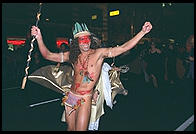
Canon EOS-1n
by Philip Greenspun; created 1995
Site Home : Photography : Canon EOS-1n
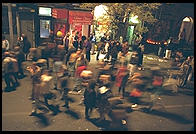 This is mostly a comparison of the EOS-1N against my experience with the EOS-5,
so if you want to understand it, you'll probably have to read my
review of the EOS-5 first.
This is mostly a comparison of the EOS-1N against my experience with the EOS-5,
so if you want to understand it, you'll probably have to read my
review of the EOS-5 first.
Right now this is based on one night's rental of the EOS-1n (for the Halloween Parade in Greenwich Village; it was raining and I wanted the AF assist light on the 540EZ to light up).
My first sensation upong hanging the EOS-1N, Power Booster E1, 540EZ flash, and 35-350L lens around my neck was that of the floor contacting my face. If you want an EOS-1 with the vertical grip and the motor drive speed of the EOS-5/VG-10, you're going to pay a big price in terms of weight. Personally, I think I'd go for the BP-E1, a plastic battery-holding grip, and live with 3 fps. One really nice thing about the BP-E1 is that it lets you use either one big lithium or AA batteries for power.
 The eyepoint/exit pupil on the EOS-1n are insufficient for this eyeglass wearer.
Even with my glasses off, I can barely see the whole frame plus the displays. The
Nikon F4 is incomparable better in this area, but the prism is visibly more huge.
I don't think the EOS-1n is any better than the EOS-5 in terms of eyepoint/exit
pupil size and in fact may be worse because there are two displays to look at,
aperture and shutter speed on the bottom and a beautiful metering scale on the
right.
The eyepoint/exit pupil on the EOS-1n are insufficient for this eyeglass wearer.
Even with my glasses off, I can barely see the whole frame plus the displays. The
Nikon F4 is incomparable better in this area, but the prism is visibly more huge.
I don't think the EOS-1n is any better than the EOS-5 in terms of eyepoint/exit
pupil size and in fact may be worse because there are two displays to look at,
aperture and shutter speed on the bottom and a beautiful metering scale on the
right.
One of my worst complaints about the EOS-5 is that I can't see whether my 20-35/2.8 is in focus. The EOS-1n has a slightly darker focusing screen and in fact you get a little more snap-in/snap-out of focus at 20mm.
I've grown to love the Canon user interface. It is much quicker than my old Nikons. The thumb wheel on the back of the camera is truly inspired. However, the EOS-1n vertical grips do not duplicate the main control wheel as does the VG-10 for the EOS-5. Even after just five rolls of casual shooting, this proved very inconvenient. Neither does the Power Booster duplicate the AF sensor select button.
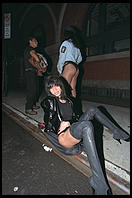 The EOS-1n has a few things over the EOS-5 in the user interface department,
however. One is that depth of field preview gets its own button, sensibly located
exactly where depth of field preview buttons are on mechanical SLRs. That means
you can use Custom Function 4, which moves AF to the AE lock button on the back,
and still have depth of field preview available (something impossible with the
EOS-5).
The EOS-1n has a few things over the EOS-5 in the user interface department,
however. One is that depth of field preview gets its own button, sensibly located
exactly where depth of field preview buttons are on mechanical SLRs. That means
you can use Custom Function 4, which moves AF to the AE lock button on the back,
and still have depth of field preview available (something impossible with the
EOS-5).
Custom functions on the EOS-1n are much more interesting and useful than on the EOS-5. My favorite, Custom Function 4, actually has three settings. The default makes the camera work like a point & shoot or Nikon F4: AF is part of the shutter release. Setting 1 moves AF to the AE lock button by your thumb so you can AF and MF at the same time with USM lenses (I love those acronyms). Setting 2 is for sports photographers. It lets them leave AF on the shutter release but stop it with the AE button. [You can do all this on the EOS-5, but it is split between two custom functions.]
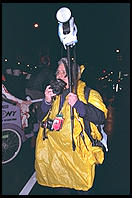 One of the first things I disliked about my EOS-5 was that the finger control
dial was the aperture in aperture-priority mode but then became the shutter speed
in manual mode. The EOS-1n lets you choose how you want to use the two control
wheels and two shift switches to change aperture, shutter speed, and AF sensor
selection. Of course, now I've gotten used to how my EOS-5s work so I probably
won't change anything.
One of the first things I disliked about my EOS-5 was that the finger control
dial was the aperture in aperture-priority mode but then became the shutter speed
in manual mode. The EOS-1n lets you choose how you want to use the two control
wheels and two shift switches to change aperture, shutter speed, and AF sensor
selection. Of course, now I've gotten used to how my EOS-5s work so I probably
won't change anything.
By default, the EOS-1n works in 1/3 stop increments for both aperture and shutter speed, but you can set it for 1 stop or 1/2 stop increments. I was very happy to be able to set it up to do 1/2 stop steps because that's how my EOS-5 works.
Still very stupid compared to Nikon, but not quite as badly engineered as the EOS-5 system. For one thing, the camera will turn on the 540EZ AF assist light in single-shot AF mode. Hallelujah. I got my $35 rental fee's worth.
 Check out my rant in the
EOS-5 review if you want to know
what's still not fixed (i.e., how off-center subjects will screw you).
Check out my rant in the
EOS-5 review if you want to know
what's still not fixed (i.e., how off-center subjects will screw you).
After the quietness of the EOS-5, the noise of the EOS-1n is startlingly loud. Between the weight and the noise, I felt like a studly photojournalist with an old Nikon F3 and motor drive. Unless you really want to run infrared film through your camera at 6 fps, I think the EOS-5 and Elan drive systems are far superior (they fog IR film, though, with a little sensor LED).
 Allegedly the EOS-1n will take a lot more rain than the EOS-5, which was why I
rented it. However, I've not yet found the limits of the EOS-5s in terms of water
tolerance so I can't say the EOS-1n is better. I've heard rumors on the Net that
the EOS-1n is designed for up to 1/3 of an inch of rain per hour, but who
knows.
Allegedly the EOS-1n will take a lot more rain than the EOS-5, which was why I
rented it. However, I've not yet found the limits of the EOS-5s in terms of water
tolerance so I can't say the EOS-1n is better. I've heard rumors on the Net that
the EOS-1n is designed for up to 1/3 of an inch of rain per hour, but who
knows.
The top LCD display has a little light for night photography. Rewind is unbelievably fast. In exposure lock mode, the in-finder display shows you the difference between what you locked and what the camera would choose in the new composition; you can use use this to see the range of the scene (up to 6 f-stops). Built-in finder dioptric adjustment.
No battery level reminder, not even on power-on when the battery is getting low. If you don't remember to explicitly check, you could end up dead in the water.
I'd like to try the RS version and see if I get better sports pictures. This is the $2500 10 fps EOS-1N that has a stationary pellicle mirror. You lose 1/3 stop of light but the finder never blacks out.
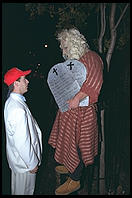 I'm not sold on the EOS-1N. If you do a lot of nighttime flash
photography, if you want to play with the RS version, if you spend a lot of time
in the rain, it is probably worth buying one (after all, it is only about the
price of an L lens and you can always sell it). However, if you don't have an
unlimited budget, I think you are better off with an EOS-5 and a 70-200/2.8L
(about the same price as the EOS-1n and Power Booster).
I'm not sold on the EOS-1N. If you do a lot of nighttime flash
photography, if you want to play with the RS version, if you spend a lot of time
in the rain, it is probably worth buying one (after all, it is only about the
price of an L lens and you can always sell it). However, if you don't have an
unlimited budget, I think you are better off with an EOS-5 and a 70-200/2.8L
(about the same price as the EOS-1n and Power Booster).
Remember that the EOS-5/A2E came out in 1992 and Canon tends to replace their SLRs every four years. The successor to the EOS-5 will probably be my new favorite body.
Text and pictures (c) Copyright 1991-1995 Philip Greenspun